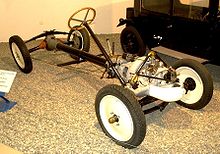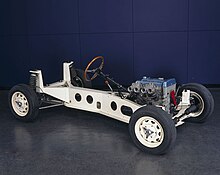|
Backbone chassis
  Backbone tube chassis is a type of automobile construction chassis that is similar to the body-on-frame design. Instead of a two-dimensional ladder-type structure, it consists of a strong tubular backbone (usually rectangular in cross section) that connects the front and rear suspension attachment areas. A body is then placed on this structure. It was first used in the English Rover 8hp of 1904 and then the French Simplicia automobile in 1909.[1] The backbone chassis was extensively developed by Hans Ledwinka who used it in greater numbers on the Tatra 11 and subsequent vehicles. Ledwinka later used backbone frames with central tube and axles with swinging driveshafts on Tatra trucks, becoming known as Tatra-concept.[2][1] DesignThe truck backbone chassis is a design feature of Czech Tatra heavy trucks[3] (cross-country, military etc.). Hans Ledwinka used this style of chassis for the Tatra 11 car in 1923.[2] He then developed the design on trucks with 6x4 model Tatra 26, which had excellent off-road abilities.    This type of chassis has been used in numerous sports cars. It does not provide protection against side collisions, and thus has to be combined with a body that would compensate for this shortcoming. Examples of cars using a backbone chassis are Simplicia (1910), De Tomaso Mangusta, DMC DeLorean, Lloyd 600, Lotus Elan, Lotus Esprit and Europa, Škoda Popular, Škoda Rapid, Škoda Superb, Tatra 77, Tatra 87, Tatra 97, Toyota 2000GT and TVR S1. Trucks with a backbone chassis include the Tatra 111, Tatra 148 and Tatra 815. Some cars also use a backbone as a part of the chassis to strengthen it. Examples include the Volkswagen Beetle, where the transmission tunnel forms a backbone. Hybrid backbone-ladder chassisThe Locost may appear to be using a backbone in addition to the outer space frame. But examination shows that, in standard form, it is adding negligible stiffness and only serves as a convenient support structure for the sheet metal panels forming the transmission tunnel. The Triumph Herald and Triumph Vitesse used a twin flanged box section[4] backbone carrying the main torsional[citation needed] and bending loads, with light channel section side rails to stiffen the body, while the Triumph Spitfire and Triumph GT6 sports cars used only the twin-box section backbone, with separate side members in the body, and rear suspension fore and aft loads were also taken by the floor, not the backbone chassis directly. Advantages
Disadvantages
See alsoReferences
External linksWikimedia Commons has media related to Backbone chassis.
|